Ireland & Britain
England & Scotland
Travel Stories
Interests & Hobbies
Outdoors & Activities
Advice for Visitors
About My Ireland Tour
News & What's On

Britain and Ireland's castles, palaces and stately homes are a treasure trove of rich history and architectural wonder. From towering fortresses of medieval heritage to more modern country estates, every brick holds the key to a bygone era where these magnificent structures were used for defence, extravagance and shows of grandeur. These buildings of the British Isles offer us a look back at how the landscape took shape and how power struggles were won. From iconic figures such as Queen Victoria and Henry VIII, to lesser known but no-less powerful figures that shaped the history of this part of the world, these are the homes they lived in.
Overseeing a strategic junction, linking the Lowlands to the Highlands, has ensured that there has been a fortress of one kind or another in this location since prehistoric times. The area surrounding Stirling Castle has witnessed two of Scotland's most important battles. The first was William Wallace's victory over the English army in 1297 at Stirling Bridge. And, the other, which saw Scotland mark its nationhood, was Robert the Bruce's triumph at Bannockburn in 1314.
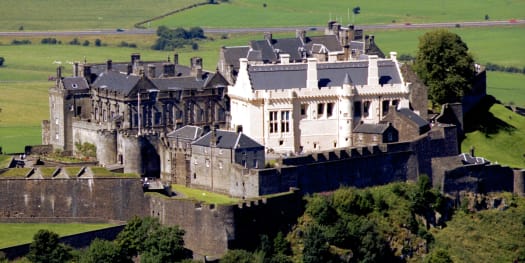
Atop Stirling Castle, you can see why it has played such a crucial role in Scottish history. Views extend to the rising Highland to the north and the River Forth below — the main route taken by invading troops as they made their way into Scotland's heartland. For a detailed lesson on the castle and its past inhabitants, which include Mary, Queen of Scots, and numerous Jameses (from whom the term "Jacobites" was created), you can head for the Castle Exhibition.
From the defensive boundaries of the castle, you'll be able to take in the stunning Forth Valley in all its glory. From here, you can tour the Great Kitchens, the main courtyard and the Royal Chapel. At the Royal Palace, you can view the famous hand-woven Stirling Tapestries, depicting the unique atmosphere of Scotland's royal court in the 1500s.
While Stirling Castle tends to be busy throughout the summer months, crowds lessen from about 4pm onwards. If you can plan your day's itinerary to arrive at the castle around this time, there's a good chance you'll have it all to yourself.
Each room in the castle has a staff member waiting to fill you in on the details, and answer any questions you may have. The nearby town of Stirling doesn't offer much in the way of excitement, but its quaint streets and picturesque Victorian homes are worth a look if you have the time.
From the 1st of April to the 30th of September, Stirling Castle is open from 9.30am to 6pm — with the last entry at 5pm.
From the 1st of October to the 31st of March, Stirling Castle is open from 9.30am to 5pm — with the last entry at 4pm.
The opening times for the museums and other independent attractions on the grounds may vary. The Regimental Museum closes 45 minutes before the castle. And, Stirling Castle is closed completely on the 25th and 26th of December.
Prices of a ticket to Stirling Castle range from £17.50 (online price) to £19.50 (walk-up price) for an adult to £10.50 (online price) to £11.70 (walk-up price) for a child.
Ireland has more than its fair share of outstanding archaeological sites, but the Rock of Cashel is arguably the most impressive. The 'rock' from which it takes its name is, in fact, a limestone hill, covered in luscious green, rising from the plain which characterises the surrounding area. The word 'cashel', by contrast, is derived from the Irish Gaelic word caiseal, meaning stone fortress.
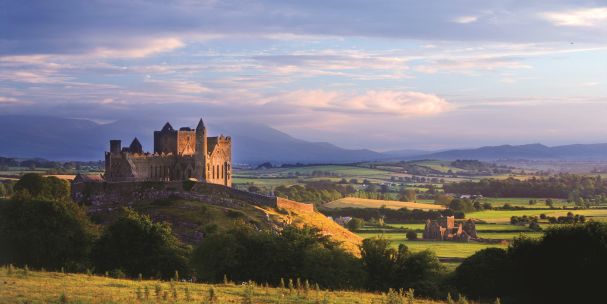
In both respects, the Rock of Cashel lives up to its title. The rock itself is vast and imposing, and one can only imagine the difficulties it would have posed for attackers throughout the ages who had designs on the stone fortress above. The masonry of the fort itself is no less spectacular and is remarkably well preserved almost a full millennium after its original construction.
The history of the site itself is long and varied. First used as a base for Welsh invaders, the Eóghanachta clan, who would become kings of this region of Ireland. The clan, and hence the rock, have been closely associated with St. Patrick (considered by many historians to be a Welshman), earning Cashel's pseudonym, St. Patrick's Rock.
Although under Eóghanachta rule, Cashel would rival Tara as Ireland's centre of power, it was wrested from their control in the Tenth Century before being presented to the Church in 1101. The site would change hands many times again in the centuries to follow, giving rise to the various buildings whose remains now occupy it.
Have a look across the fields surrounding the Rock of Cashel and enjoy the stunning views. You will be able to see the ruins of Hore Abbey.
One of the highlights is Cormac's Chapel, a beautiful example of Romanesque architecture. Access to the chapel is by guided tour only and lasts 45 mins.
The Rock of Cashel is just a five-minute walk from Cashel town. This is a busy site and might get very busy during the summer months. We would recommend that you spend between 1 to 1.5 hours at the Rock of Cashel. Public toilets are located at the car/coach park nearby.
Opening hours from early June to mid-September are from 09:00 to 19:00.
Opening hours from mid-March to early June & mid-September to mid-October are from 09:00 to 17:30.
Opening hours from mid-October to mid-March are from 09:00 to 16:30.
Tickets are €8 for an adult and €4 euro for a child. A guided tour of Cormac's Chapel costs €3 extra and needs to be booked at the entrance.
Windsor Castle overlooks both the towns of Eton and Windsor (The wealthiest town in Britain, and home to more than 250 multi-millionaires). The site of the castle was originally chosen by William the Conqueror in 1070, with its construction lasting until 1086. It was built to guard the Western approach into London. In 1992, during what Queen Elizabeth II called her 'annus horribilis', or horrible year, a fire broke out in Windsor Castle and burned for 15 hours — destroying 115 of the castle's rooms. To cover some of the cost of the rebuild, the Queen started to pay income tax in 1993, making her the first British monarch, since the 1930s, to do so.
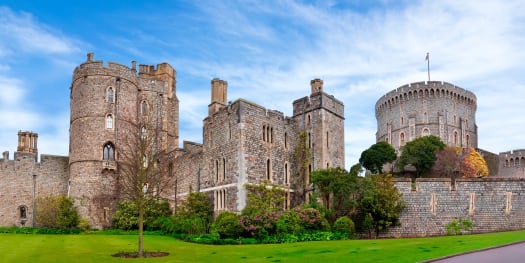
Having been the home of 40 monarchs, Windsor Castle is both the largest and oldest occupied castle in the world. It is open throughout the year to the public, and offers a fascinating look into the day-to-day lives of British Royalty. Highlights of the tour include the ceremonial rooms, especially the Grand Reception Room, which uses real gold to decorate its walls and ceiling, and is adorned with stunning chandeliers. A favour with both kids and adults alike is Queen Mary's Dolls' House — a present to Queen Mary in 1924, the miniature rooms feature art, books, furniture and even running water and electricity!
On the castle grounds, you can also explore St George's Chapel, the final resting place of Henry VIII and Queen Elizabeth II. And, on Thursdays and Sundays, there's also the chance to see the Changing of the Guard ceremony.
If you're flying into Heathrow airport, the town of Windsor will be closer to you than central London. If time allows, you can take a 10-minute car ride here, before starting your exploration of London and beyond.
Windsor Castle sits on top of a steep hill, and the visitor path covers a considerable distance, so comfortable footwear is advisable. Anywhere between 1½ and 2 hours would be plenty of time to see the highlights of the castle.
On Thursday to Monday, Windsor Castle is open from 10am to 4.05pm — and the castle is closed completely on Tuesdays and Wednesdays.
Prices of a ticket to Windsor Castle range from £28.00 for an adult to £15.50 for a child. Entry for children under 5 is free.
Found in the village of Bunratty County Clare, between Limerick City and the town of Ennis, Bunratty Castle is a 15th century tower house. There have been three other structures on this site before the construction of the current castle. The first structure was a settlement set up by Norsemen. King Henry III of England was responsible for the building of a motte and bailey castle. Thomas De Clare built the first stone structure on the site and this was occupied between 1278 and 1318. While De Clare was away in England, in 1284, the castle was attacked and destroyed. In 1287, De Clare had the castle rebuilt and this version stood until it was attacked again in 1318. In the same year, De Clare and his son were killed in battle.
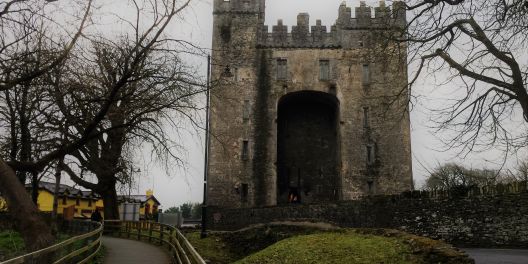
The present structure was built in 1425 by the MacNamara family. The O'Briens, Munster's most powerful clan, seized control of the castle around 1500. During the Confederate Wars (between 1641 and 1653), Rear-Admiral Penn, whose son William would go on to found the province of Pennsylvania, was in control of the castle before surrendering to the Irish Confederates and being allowed to sail to Kinsale. Bunratty Castle was then past down through the O'Brien family before it was sold to the Studdert family around 1720. When the Studdert family left the estate, to move to the nearby, more modern, 'Bunratty House', the castle fell into disrepair. In 1956 the 7th Viscount Gort and the Office of Public Works restored the castle and in 1960 it was opened to the public. Today the castle and its folk park can be visited for a small fee.
Located near the village of Robertsbridge, in East Sussex, Bodiam Castle was first built by Sir Edward Dalyngrigge in 1385. Due to fears of a French invasion during the Hundred Years' War, the castle was the brainchild of Richard II — the King of England from 1377 to 1399. The Dalyngrigges family owned Bodiam Castle for several generations before it was passed, by marriage, to the Lewknor family. Sir Thomas Lewknor supported the House of Lancaster during the Wars of the Roses. However, when Richard III from the House of York became king in 1483, forces gathered to lay siege to Bodiam Castle, and it is thought that it was surrendered without much resistance.
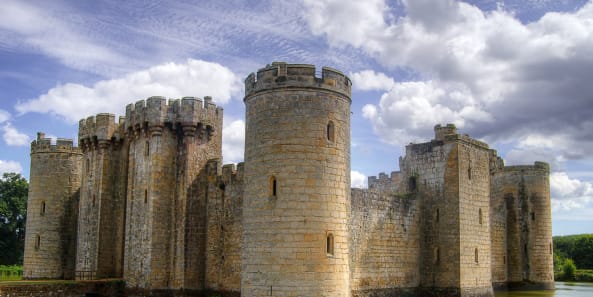
Bodiam Castle was dismantled sometime after 1641 and was left in ruin until it was purchased by politician John Fuller in 1829. Fuller restored the castle to a degree, before selling it. Each of the subsequent owners has added restoration measures, and since 1925 it has been owned by The National Trust and is listed as both a Scheduled Monument and a Grade I listed building.
Grab some refreshments at the Wharf Tearoom, boasting panoramic views of the River Rother and a selection of hot and cold drinks, light lunches, and homemade cakes. There's also the Castle View Café, where you can pick up drinks and snacks.
While most of the castle is accessible to wheelchair users and those with mobility issues, some areas may be too narrow and uneven to traverse. There is also free parking available, and the area around the castle is well worth a stroll, featuring expansive parkland, wetlands, and lush grasslands.
Bodiam Castle is open from 10am to 5pm daily.
Prices of a ticket to Bodiam Castle range from £14.50 for an adult to £7.20 for a child.
The Eilean Donan Castle was first built during the 13th century, during the time of the Vikings first settling in North West Europe. For the majority of its early life, the castle was owned by the Clan Mackenzie alongside their trusted allies the Clan MacRae. As the threat of Viking invasion lessened, so too did the size of the castle. Since it was first established, Eilean Donan Castle has been built and rebuilt four times. In 1719, as part of the British Jacobite rising the castle was destroyed following its invasion by government troops. For the following 200 years, the castle stood in ruins. Lt Colonel John Macrae-Gilstrap bought Eilean Donan Castle, and dedicated the following 20 years of his life to its restoration.
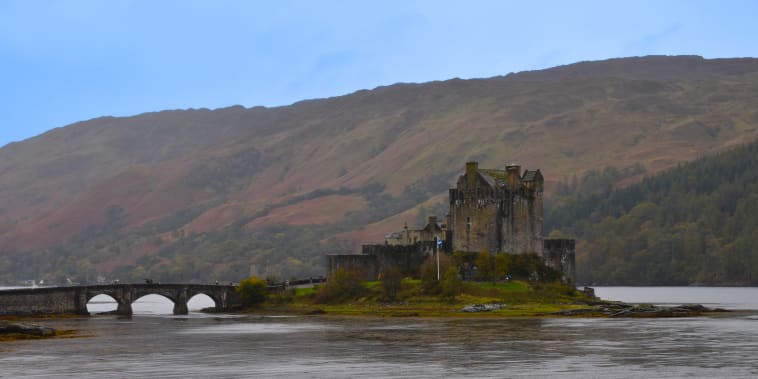
Today, although the castle is officially run by the Conchra Charitable Trust, the castle is still owned by John Macrae-Gilstrap and his descendants. As soon as you see Eilean Donan Castle in person, you'll know why it's classed as Scotland's Most Photographed Castle. The castle sits proudly on a small island on pristine waters, and is accessible via a narrow stone bridge from the mainland. Please note, that this bridge as well as parts of the castle interior can be challenging for those with mobility issues.
Inside the castle, visitors are treated to a variety of rooms, objects and hidden passages — some of which are only accessible at quieter times of the year. Children are especially catered for with interactive puzzles and games along the way. Keep an eye out for the 3 fake mice hiding in the staged kitchen! A full tour usually takes about an hour, and there is a coffee shop in the visitor centre for cakes and refreshments at the end.
Accessing Eilean Donan Castle can pose significant challenges, even for individuals with no mobility issues. Designated as a "Scheduled Monument" by the Scottish Government, the castle is subject to strict regulations that prohibit alterations to its infrastructure, such as the installation of elevators or handrails. Unfortunately, these restrictions render the castle inaccessible to individuals using wheelchairs or walkers. However, the visitor centre remains easily accessible to everyone.
Even though it's known as Scotland's Most Photographed Castle, photos inside Eilean Donan Castle are prohibited. Exterior photos, on the other hand, are encouraged. And, it's hard to take a bad one, thanks to the epic setting! The castle is located nearby to the Scottish Highland fishing village, which is equally photogenic and worth a visit. Eilean Donan Castle is quite a distance from the cities of Edinburgh and Glasgow, so would fit in better with a tour of the Highlands, rather than a day trip from the city.
From the 26th of March to the 28th of October, Eilean Donan Castle is open from 9.30am to 5pm — with the last entry at 4pm.
From the 29th of October to the 25th of March, Eilean Donan Castle is open from 10am to 4pm — with the last entry at 3pm.
Prices of a ticket to Eilean Donan Castle range from £11.00 for an adult to £6.50 for a child over 5. Entry for children under 5 is free.
Situated five miles north-west of Cork city, Blarney Castle is a solid fixture on almost any tour of Ireland itinerary. It is best known for the famous "Blarney Stone" which visitors are encouraged to kiss, in accordance with a tradition that spans the centuries. Those who kiss the Blarney Stone are said to magically receive the "gift of the gab", — or as we call it in Ireland... a load of old Blarney.
Built over 600 years ago by Cormac MacCarthy, one of Ireland's greatest chieftains, Blarney Castle has attracted millions of visitors who continue to flock here hoping to be gifted with the power of persuasive and elegant speech. Visitors can now explore the castle's stunning gardens and interior, including the winding staircase and dungeons.
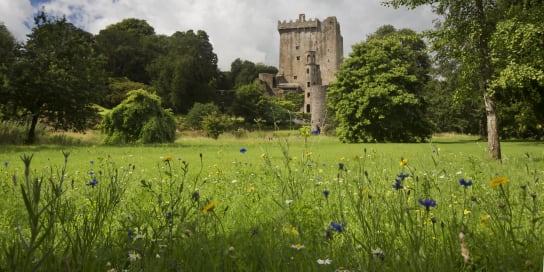
During the mid-17th century Irish Confederate Wars, the castle was besieged by British forces led by Oliver Cromwell's commander, Lord Broghill. It was eventually captured after heavy bombardment, resulting in its partial destruction.
While not the largest or most imposing of Irish castles, Blarney Castle has a certain charm and elegance that's hard to forget. You can also look inside the adjacent Blarney House, a stately mansion built during the 18th century and the nearby Blarney Woollen Mills, an Irish heritage shop famous for its wool garments and a fantastic café!
The spiral steps to the famous Blarney Stone can feel very narrow at peak times. Those with limited mobility should proceed slowly and carefully, however many people may be waiting behind.
Buy your tickets online to get an online discount.
You will find Blarney Castle 8 km from Cork City in Blarney Village. We recommend spending 3 hours exploring the castle and garden as well as the caves, lake walk, fern garden and arboretum. Maps are available at the ticket office in several languages. Audio guides in English are also available.
The opening hours for Blarney Castle and Gardens every day in May through September are 9am to 6pm. Opening hours are shortened from January to May. The opening hours can change according to weather conditions. Find out more about the opening hours.
A ticket for Blarney Castle costs €22 for adults, and €10 for children aged between 6 and 16. Students' and seniors' tickets cost €17.
Alnwick Castle is located in the town of Alnwick in northeast England, and has a history that spans over 950 years. The first castle was built in this location during the Norman period, and is today the seat of 12th Duke of Northumberland. The castle is one of the main tourist attractions of the Northumberland region and in 2016 it was combined with the nearby Alnwick Garden and received over 600,000 visitors that year.
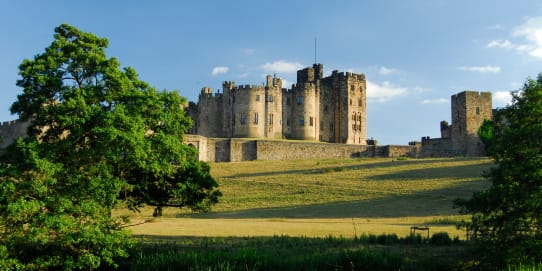
The structure we see today was designed by Ivo de Vesci, Baron of Alnwick, in 1096 and is situated alongside the River Aln. Alnwick Castle was captured in 1136 by King David I of Scotland, and was besieged in 1172 and 1174 by William the Lion, King of Scotland. Powerful lords at the time, the Percy family, acquired the castle after they rebelled against and eventually dethroned King Richard II of England. From that date until the present day, Alnwick Castle has been owned by the Percy family. Ralph Percy, his wife, and their four children currently reside here.
As you wander through Alnwick Castle and Alnwick Garden, see if you can spot some of the filming locations from such movies and TV shows as Robin Hood: Prince of Thieves, Harry Potter and the Chamber of Secrets, The Black Adder and Downton Abbey.
The castle is closed from the end of October until the end of March every year, and opening hours vary depending on the time of the year. Depending on the time of year of your visit, you may also be able to catch an outdoor concert, a medieval re-enactment and other seasonal festivities. There are ramps and lists through the castle, allowing easy access for wheelchair users and those with mobility issues.
Alnwick Castle is open daily from 29th of March to the 24th of October.
Prices of a ticket to Alnwick Castle range from £20.50 for an adult to £10.80 for a child.
Kilkenny Castle stands proudly on the banks of the River Nore. It is a prominent feature in the landscape of this famous tourist town, which is located less than two hours from Dublin. Built by the powerful Butler family in 1195, the original fortifications were made of wood and designed in the prevailing Norman style of that period. By the 18th century, the Butler family began to lose their power and their wealth and Kilkenny Castle fell into disrepair. When Anne Wandesford married John Butler, wealth was once again brought into the family and the castle was once again refurbished and brough back to its past glory.
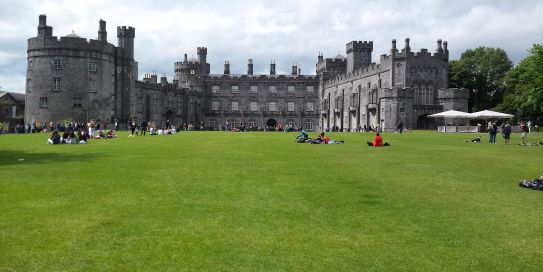
What visitors see today is a 19th century structure that has undergone numerous expansions and renovations and is more akin to a Renaissance-style mansion than a castle. Every year, around 500,000 people come to visit the estate and wander through its fifty-acre park, which is packed with a variety of wildlife and ancient trees. The main attractions include the intricately designed rose garden, the expansive woodlands, and the man-made lake.
Be sure to stop at the formal Rose Garden with fountains for a group photo before taking the family to the outdoor play area. Afterwards, the grown-ups can refuel with coffee and cakes in the Castle Kitchen.
Kilkenny Castle is accessible via wheelchair, and there is a room by room audio guide available for those with hearing impairments. There is no car park on the grounds, although there is disabled parking spaces on the nearby streets.
Kilkenny Castle is open daily from 9:am to 5:30pm.
Prices of a ticket to Alnwick Castle range from €8 for an adult to €4 for a child.
Edinburgh Castle, standing proudly over Scotland's capital for almost a millennium, serves as a powerful symbol of national pride and testament to the country's captivating history. Over the centuries, the castle grounds have played diverse roles, functioning as a royal residence, a prison, and a fortress. Impressively, the castle has weathered 26 sieges without ever being breached. Today, it stands as one of Britain's most cherished tourist destinations. During its time as a royal residence, Mary Queen of Scots gave birth to her son James VI in the royal palace. The grounds are also home to Edinburgh's oldest building, St. Margaret's Chapel, named in honour of Queen Margaret.
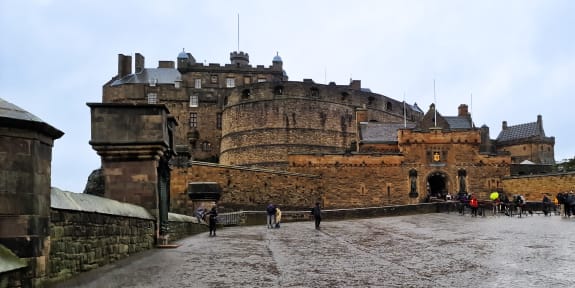
Approaching from the top of The Royal Mile, a road connecting Holyrood Palace to Edinburgh Castle, you enter the castle through the expansive courtyard known as the Esplanade. Built in 1753 as a platform for Edinburgh Military events, the Esplanade in more recent times plays host to The Royal Edinburgh Military Tattoo every August, featuring military music and marching performances. From here, pass through the castle gatehouse, guarded by statues of Scottish heroes Robert of Bruce and William Wallace (Braveheart).
Within the castle grounds, notable attractions include the Argyle Battery, one of the five cannon firing stations, the One O'Clock Gun (fired every day at 1pm, except on Sundays, Christmas Day and Good Friday, with a resounding cannon blast), as well as St. Margaret's Chapel, the Grand Hall, and the Scottish National War Memorial.
It is advisable to book your Edinburgh Castle tickets as far in advance as possible. This will ensure entry, as well as the best possible price. Once tickets are put on sale they tend to sell out quickly, this is especially true for visits during the peak summer months.
For those looking to take in all that Edinburgh Castle has to offer, at a leisurely pace, allocating approximately two hours would be ideal. While most of the castle grounds are flat and easy to get around, there are areas of cobblestone and steps, which may pose challenges for those with mobility issues. The Redcoat Café, located alongside the One O'Clock Gun has step-free access. A noteworthy consideration: the firing of the One O'Clock Gun makes a sudden and loud noise. If this is an issue for anyone in your group, there are ear defenders available via members of staff.
From the 1st of April to the 30th of September, Edinburgh Castle is open from 9.30am to 6pm — with the last entry at 5pm.
From the 1st of October to the 31st of March, Edinburgh Castle is open from 9.30am to 5pm — with the last entry at 4pm.
The opening times for the museums and other independent attractions on the grounds may vary. And, the castle is closed completely on the 25th and 26th of December.
Prices of a ticket to Edinburgh Castle range from £19.50 for an adult to £11.40 for a child. Entry for children under 7 is free, but a ticket is required.
For his service to the crown, Richard Talbot was given the lands and harbour of Malahide in 1185. Talbot originally built a wooden stronghold and eventually a stone structure on the site of the current Malahide Castle. The Talbot family lived on the grounds from 1185 until the 1970s. Their time here was only interpreted from 1649 to 1660 when Cromwellian soldiers took over the castle. Lord Milo Talbot was to become the last Baron of Malahide. After his death in 1973, his sister Rose inherited the land and sold it to the Irish State in 1975.
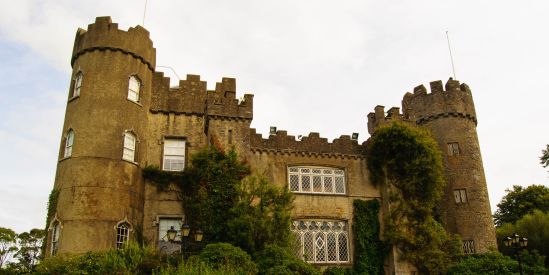
Today, you can visit the Malahide Castle on a guided-tour-only basis and private rooms can also be booked for functions. The castle welcomes thousands of local and international visitors each year, as well as playing host to social and political summits and gatherings.
A visit to Malahide Castle takes around one hour to complete so the Avoca self-service café, food market and store are a great addition the grounds and a lovely way to relax after your tour.
Located just a 10-minute drive from Dublin Airport, Malahide Castle is a great way to start or end your tour of Ireland. And, if you're travelling with kids, there's endless entertainment in the fairy trails, the butterfly house and the botanical gardens.
Malahide Castle is open daily from 9:30am to 5:30pm.
Prices of tickets to Malahide Castle range from £16 for an adult to £10 for a child.
Located in the coastal town of Dover, England, atop its famous White Cliffs, Dover Castle has a fascinating history that dates back over 2,000 years. First developed during the Roman conquest of Britain, which began in 43 AD, the structure we see today was built shortly after the Battle of Hastings in 1066. On a clear day, you can see France across the English Channel from the castle, making it a prime location to monitor impending invasions coming from that direction. The site of the castle is also notable for having one of the three remaining Roman lighthouses in the world.
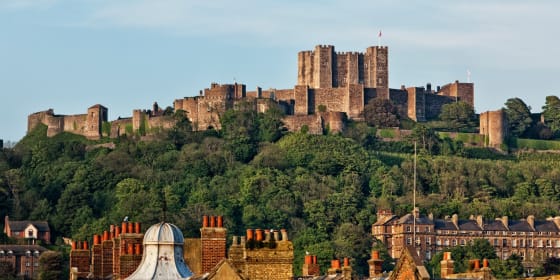
Between 1179 and 1188, under the reign of Henry II, Dover Castle was significantly redeveloped and fortified with the addition of the inner and outer baileys and the central keep — the central section of the castle, a place of last resort during a siege or attack. The castle was redeveloped again during the 18th century Napoleonic Wars, as Dover's location again became crucial to England's safety against potential attacks from France.
A visit to Dover Castle allows you to enter the iconic Great Tower, home to reimagined medieval interiors and stunning views of its battlements and surrounding landscape. As well as a tour of its underground and the Secret Wartime Tunnels, Allied Forces used an extensive series of tunnels as a military command centre in World War II.
In addition to Dover Castle, there are other interesting places to visit in the town. Dover Museum provides a captivating insight into the history of the town, while the breathtaking views from the White Cliffs of Dover are worth the trip alone. The local restaurants around the harbour serve authentic Kentish cuisine, a bonus for food lovers.
Getting around Dover Castle will involve a lot of walking, while most areas are accessible to those with mobility issues, some areas are only accessible via narrow pathways and stairways that are not. If you're planning a trip to the castle along with other activities in Dover, we'd recommend that you set aside at least three hours here, there's a lot to see. You can also enjoy refreshments at the on-site café, tea-room and restaurant.
Dover Castle is open daily from 10am to 5pm.
Prices of tickets to Dover Castle range from £23.00 for an adult to £14.00 for a child.
Belfast Castle, an iconic landmark perched on the slopes of Cave Hill, offers a fascinating glimpse into the rich history and cultural heritage of Northern Ireland. Its origins trace back to the 12th century, when the Normans first constructed a fortification in the area. However, the castle we see today has undergone several transformations, reflecting the changing times and fortunes of its owners. In 1611, Sir Arthur Chichester, the Baron of Belfast, embarked on a significant rebuilding project.
This new iteration of Belfast Castle was constructed using stone and timber, creating a robust and imposing structure. However, this version of the castle came to a tragic end when it was destroyed by fire in 1708. The Chichester family decided not to rebuild on the same site, leading to the creation of the current Belfast Castle on Cave Hill.
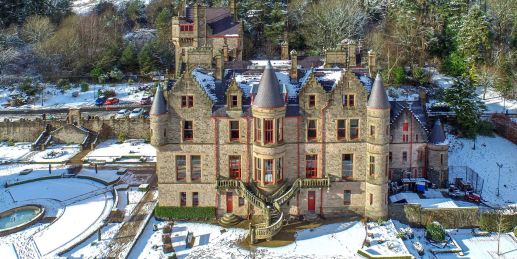
The present Belfast Castle, completed in 1870, owes its existence to Lord Ashley, the 8th Earl of Shaftesbury, a relative of Sir Arthur Chichester. The building of the castle, which cost £11,000, was a substantial investment at the time. The design, undertaken by the architect John Lanyon, features a Scottish baronial style, particularly in its turrets and gables. Lord Ashley inherited Belfast Castle in 1884, further strengthening the Shaftesbury family's connection to the site.
Today, Belfast Castle is used as a venue for contemporary events. Its meticulously landscaped gardens, offering unmatched views of the city and the surrounding countryside, make it a popular spot for afternoon tea, weddings, and other public engagements. The castle's interior is carefully maintained and restored, giving a regal backdrop for celebrations, conferences, and cultural events.
Keep an eye out for the resident white cat of Belfast Castle. The cat is said to bring good fortune to those who visit, as long as the tradition of keeping a white cat as a castle resident is upheld.
You'll find access to Belfast Castle from Belfast City centre, with a number of buses running to the Cave Hill area. The bus ride takes about 20 minutes in total. The tour is self guided and you can choose your own route around the castle. Restrictions are often in place in the interior, and many rooms may be closed off or out of bounds.
Belfast Castle is open from 9am to 6pm daily.
Belfast Castle is free to enter.
Urquhart Castle is situated in the Scottish highlands and overlooks the famous Loch Ness, Scotland. Remains of a fortification dating as far back as the medieval era were uncover on the site, but the ruins of today date back from between the 13th and the 16th centuries. With a turbulent history, which includes multiple raids and a important role in the Wars of Scottish Independence during the 14th century. Urquhart Castle was in use until 1692, and has laid abandoned ever since.
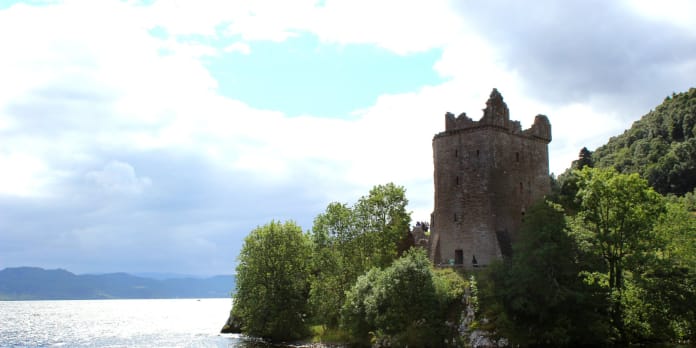
During the 19th century, the castle was considered a romantic ruin by artists and tourists visiting the Scottish Highlands. Following the death of its then owner, Ian Charles Ogilvie-Grant, in 1913 the castle was transferred to His Majesty's Works and Public Buildings.
Besides Urquhart Castle being located alongside, arguably Britain's most scenic lake, the castle is also famous for its tower. The primary defensive structure of the castle, Grant Tower is the structure that is visible from Loch Ness and was named after the Grant family who owned the castle from 1502 to 1512. As well as Grant Tower, visitors can also travers the gate house, the hall range and both baileys. While Loch Ness itself is the main attraction in town, the ruins of Urquhart Castle bring a picturesque and somewhat eerie focal point to the region.
For the best view of Urquhart Castle and the perfect exterior shot, the pristine waters of Loch Ness are your best bet. There are several cruise boat companies operating in the area, and all of them will get you up close to the castle.
Scotland is known for its erratic weather, especially in the Highlands. So dress in layers, with easy access to more or less as you need. The grounds of Urquhart Castle are uneven and steep in places, and may not be suitable for visitors with mobility issues.
Urquhart Castle is open daily from 9:30am to 8pm.
Prices of a ticket to Urquhart Castle range from £13 (online price) and £14.50 (Walk-up price) for an adult to £7.80 (online price) and £8.70 (Walk-up price) for a child.
First built as a wooden fortress in 1068 by William the Conqueror, Warwick Castle is located in the England town of Warwickshire. The castle was rebuilt with stone in the 12th century and was fortified during the Hundred Years War, resulting in its famous military architecture. The castle then served as a fortress until James I granted it to Sir Fulke Greville in 1604 who, in turn, converted it into a country house at a huge expense. Shortly after finishing this project, Greville was killed by one of his servants, and his ghost is said to haunt the property ever since.
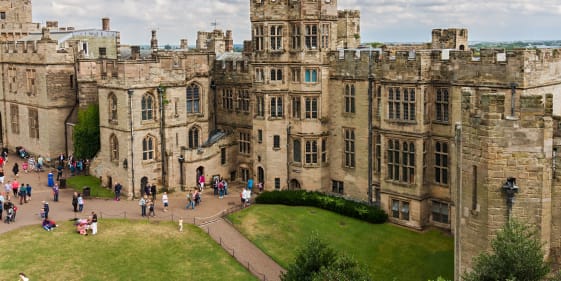
In its lifetime, Warwick Castle has had 36 different owners, and in 1978 the castle was purchased by Merlin Entertainments — which also owns the likes of Madame Tussauds waxworks and Legoland Theme Parks. Since Merlin Entertainments acquisition of Warwick Castle, it has been open to the public. During special events at the castle, visitors can see live jousting, music concerts and Britain's largest birds of prey shows.
The castle is surrounded by a dry moat, with the River Avon flowing against its southern walls. The walls of the castle are 140 yards long and 90 yards wide. To enter the castle, you can use one of two gates found on the north and west walls.
Many castles in Britain and Ireland have the atmosphere of a library and can seem stuffy and boring to younger family members. Warwick Castle is very different. From talking heads in the gallery paintings to the falconry shows, to midsummer carnival events — they have ensured that children and everyone else have been thoroughly entertained.
You'll find a great variety of restaurants and cafés within the 64 acres of Warwick Castle's grounds. These range from elegant establishments where you can relax with an afternoon tea, to quick grab-and-go options serving pies, ice cream and fish & chips. Most of Warwick Castle is accessible for people with mobility issues, and wheelchairs to rent on-site.
Warwick Castle is open from 10am to 4pm daily, and until 5pm on selected days.
Prices of a ticket to Warwick Castle range from £39 for an adult to £34 for a child.
Buckingham Palace is the British Royal Family's premier residence since 1837. It was first built in 1703 for the Duke of Buckingham, and was later acquired by King George III. The palace today is made up of a total of 755 rooms. These include 52 Royal and guest bedrooms, 188 staff bedrooms, 92 offices and 78 bathrooms. The 19 State Rooms are open to the public between July and September, while the King is away for the summer holidays. These rooms are always a popular visit, and are adorned with extravagant decor and priceless art.
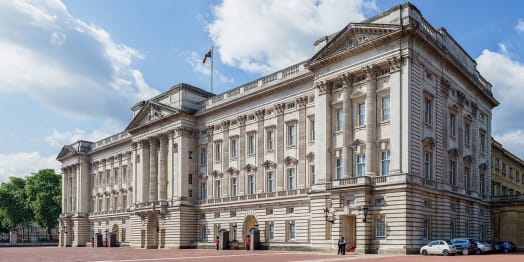
Even if you're near Buckingham Palace outside of the summer months, it is still worth the visit. While you won't have the chance to go inside, a walk through its mall is a treat at any time of the year — particularly on Sundays when it becomes a traffic-free zone.
The Changing of The King's Guard takes place on Mondays, Wednesdays, Fridays and Sundays from August to May, and daily from June through July. This is the ceremony that sees the palace guards (Yeomen Warders, also known as Beefeaters) change shifts. The Changing of The King's Guard starts at 10.45am and lasts for 45 minutes.
To see The Changing of the King's Guard, you should arrive as early as possible. You can see the Soldiers gather at St James's Palace and Wellington Barracks from 10am, reaching Buckingham Palace at 10.45am. For the best view, getting a spot outside Buckingham Palace at around 9am is advisable.
For tours inside Buckingham Palace (only available between July and September), you should arrive 30 minutes before the entry time of your ticket. Photography of any kind, as well as eating and drinking, are not allowed inside the palace — except for bottled water. Bathrooms are available for use at the start and end of your tour.
From the 14th of July to the 31st of August, The State Rooms of Buckingham Palace are open to the public from 9.30am to 7:30pm.
From the 1st of September to the 24th of September, The State Rooms of Buckingham Palace are open to the public from 9.30am to 6:30pm — with the last entry at 4pm.
Prices of a ticket to The State Rooms of Buckingham Palace range from £32.00 (online price) and £32.00 (on the day price) for an adult to £16.00 (online price) and £17.50 (on the day price) for a child. Entry for children under 5 is free, but a ticket is required.
Located in the London Borough of Richmond-upon-Thames, in Surrey, England, Hampton Court Palace was first established in 1514 as a gift to Cardinal Thomas Wolsey. Wolsey, who was the chief minister of Henry VIII, later fell from the good graces of the King and handed the palace back to him. A fortune was spent by Wolsey to restore and extend the palace, and much of his work can still be seen today. His additions include the inner gatehouse, the Clock Court and the Base Court — forty-four lodging rooms for guests of the palace.
Possibly the most famous structure of Hampton Court Palace is Anne Boleyn's Gate. Named after Henry VIII's second wife, the apartments where she was to reside were still under construction when Henry had her beheaded — taking the second place in the popular mnemonic for the fates of Henry VIII's six wives: "Divorced, beheaded, died, divorced, beheaded, survived".
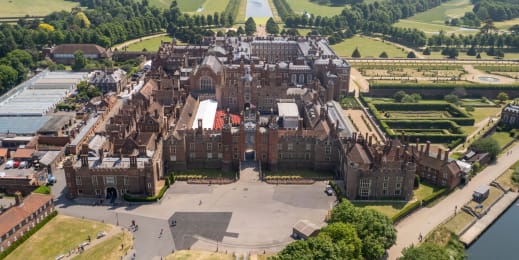
After King Henry VIII died in 1547, Hampton Court Palace was passed down to his heirs, who in turn lived there, added to Wolsey's vision via extensions and refurbishments, and left in unoccupied and in disrepair — in the 17th century, Hampton Court Palace was seen by British royals as being old-fashioned in comparison to France's more modern courts such as Versailles. In 1838, during Queen Victoria's reign, the Great Hall was restored and Hampton Court Palace was opened to the public for the first time.
Today, the most popular attractions within the palace include Anne Boleyn's Gate, the works of art from the Royal Collection, the Chapel and the pristinely maintained grounds which have remained almost the same as they were in the 17th century.
A wander through the palace at your own pace is very enjoyable, but taking a guided tour will allow you to find out all about the rich history waiting around every corner. The palace's kitchen is a must-visit as well. Watch a demonstration of historical cooking techniques and enjoy the sights, sounds and smells of the time.
A good 3 to 4 hours is advisable to take in all that Hampton Court Palace and its grounds have to offer. If you're travelling from London, then driving can be a little tricky — getting the train from Waterloo Station in central London is a much more hassle-free option. These trains leave every 30 minutes and drop you right to Hampton Court station.
Hampton Court Palace is open from 10am to 5:30pm Wednesdays to Sundays, and is closed Mondays and Tuesdays.
Prices of a ticket to Hampton Court Palace range from £30 for an adult to £15 for a child. Entry for children under 5 is free.
Located in the Royal Borough of Kensington and Chelsea, London, England, Kensington Palace resembles a two-storey mansion rather than a palace. First built by Sir George Coppin in 1605, its first royal occupants were King William III and Queen Mary II. They had decided to leave the foggy surrounds of Whitehall Palace due to William's chronic asthma. After they purchased the estate for £20,000, they immediately set architect Sir Christopher Wren to work expanding the house.
Mary II died of smallpox in 1694, and in 1702, after William III fell while horse-riding in Hampton Court Palace, he died after a bout of pneumonia. The palace has remained in the British Royal Families ownership ever since. Notable monarches to have resided here include King George I and King George II, Queen Anne, and Queen Victoria.
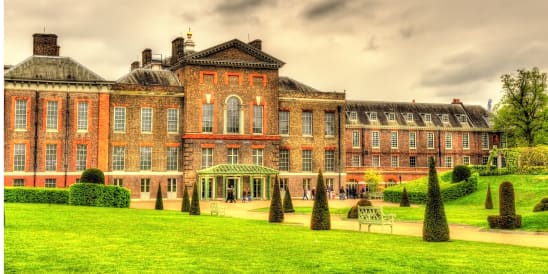
Today, Kensington Palace is the royal residence of William and Kate Windsor, also known as the Prince and Princess of Wales, as well as numerous other members of the royal family including Princess Eugenie, and the Duke and Duchess of Kent.
The only area of the palace that's open to the public is the State Rooms. These rooms include the King's State Apartments and the Queen's State Apartments, a series of lavish and spctacularrly decorated rooms where English Kings and Queens throughout history held official ceremonies and receptions. Also visible to the public are Queen Victoria's Apartments and the Victoria Revealed Exhibition, allowing visitors to view personal objects and interactive displays aimed at getting a better understanding of one of England's most controversial monarchs.
As well as the State Rooms, visitors to Kensington Palace are welcome to walk through the palace's stunning landscaped gardens. Within the gardens, keep an eye out for the statue of Diana, Princess of Wales.
Kensington Palace has numerous restrooms, and a gift shop selling royal-themed products as well as a number of cafés and restaurants. nearby attractions include Hyde Park, the Victoria and Albert Museum and the Natural History Museum.
Kensington Palace is open from 10am to 6pm Wednesdays to Sundays, and is closed Mondays and Tuesdays.
Prices of a ticket to Kensington Palace range from £24 for an adult to £12 for a child.
The Palace of Holyroodhouse is the official residence of the British Monarch in Scotland. Nestled in Edinburgh's iconic Arthur's Seat area, the palace bookends The Royal Mile along with Edinburgh Castle. Once the home of Mary, Queen of Scots, today the palace hosts engagements for the British royal family. During her reign, Queen Elizabeth II held over 50 parties in the palace's gardens. In July 2023, King Charles III was presented with Scottish Crown Jewels at a ceremony in the palace.
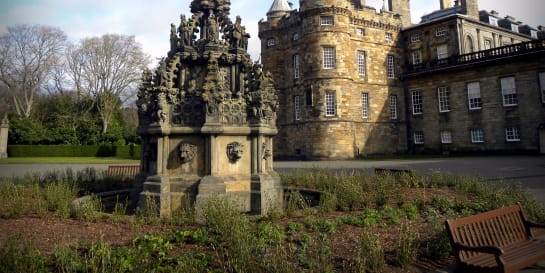
A tour through the palace takes you on a journey through time, and through the changing tastes and fashions of successive monarchs. From the bedchamber of Mary, Queen of Scots, to the Throne Room featuring a pair of thrones commissioned by King George V. Perhaps the most impressive room of all is the King's Bedchamber. Featuring a collection of French and Flemish tapestries draping its walls.
At any time of the year, the palace gardens, are a glorious sight. But, it really comes to life during the spring and summer months, when the colours of the flowers and chorus of songbirds are at their most vibrant.
As eating and drinking is not allowed within the palace, it's a good idea to sort all your refreshment needs at the courtyard café beforehand. The tour itself can take upwards of 2 hours.
Photography or filming inside the Palace of Holyroodhouse is not permitted. Eating and drinking are also not permitted within the castle, with the exception of bottled water. The audio guide during your tour is available in ten languages and there is an audio-descriptive tour available in English for partially-sighted and blind visitors.
From the 1st of April to the 30th of September, the Palace of Holyroodhouse is open from 9.30am to 6pm — with the last entry at 5pm.
From the 1st of October to the 31st of March, the Palace of Holyroodhouse is open from 9.30am to 5pm — with the last entry at 4pm.
Prices of a ticket to the Palace of Holyroodhouse range from £18.00 for an adult to £10.00 for a child.
Also known as the 'Palace of the Peak', Chatsworth House is located 3 miles northeast of the charming village of Bakewell. Since 1552, it has served as the residence for the earls and dukes of Devonshire. There is a priceless collection of paintings and period furniture housed within its wall. Set upon 25 square miles of meticulously landscaped grounds and ornamental gardens, parts of which were designed by renowned gardener and landscape architect Lancelot 'Capability' Brown during the 18th century.
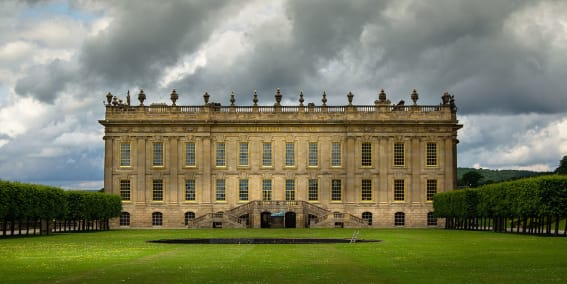
A tour of the expansive Chatsworth House and its gardens include some of Europe's most precious art pieces, a working farmyard and acres of pristine gardens and water features. This is the Peak District at it most sublime. In the 1995 film adaption of Jane Austen's Pride and Prejudice, Chatsworth House was used as Pemberley, the residence of Mr Darcy.
For those with kids of a certain age, who may not be too entertained by mural-adorned staterooms and opulent apartments, the farmyard adventure playground is sure to keep them occupied. There is also a café, located just outside the gift shop that serves, possibly, the greatest sausage roll in all of Britain.
Photography is not allowed within Chatsworth House and Gardens, but it is not to be used for any commercial purposes.
Chatsworth House is open daily from 10am to 5:30pm.
Prices of a ticket to Chatsworth House range from £34 for an adult to £19 for a child.
Even the briefest visit to this Palladian mansion, with extensive Italianate gardens, will give a sense of the inequality which existed in Ireland during the 18th-century when Powerscourt was built. Originally built by Richard Cassels between 1731 and 1743, the main building was the subject of continued rejuvenation for generations to come, with considerable alterations being made in the Eighteenth and Nineteenth Centuries. The last chapter in this story of renovation would not arrive until 1974 when, tragically gutted by fire, the mansion was subjected to a painstaking restoration that continues to this day. This, sadly, restricts visitor access to the first (i.e. ground) floor.
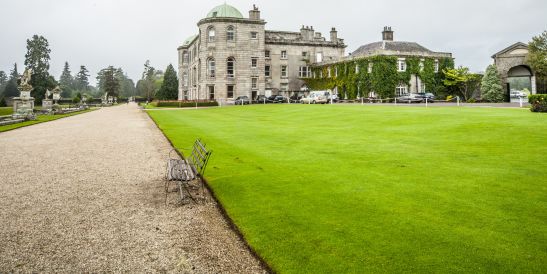
The formal gardens, redesigned in the Nineteenth Century by Daniel Robinson, are truly breathtaking in their beauty and encompass a panoply of different landscaping styles. Set amidst the Powerscourt Estate and its grounds, you will also find a hotel, a cafe, several homeware and gift shops, two golf courses and a distillery. A 6km drive from the house will take you to the Powerscourt Waterfall, Ireland's highest Waterfall. Walking to the Waterfall is not recommended as there are no footpaths next to the road.
Powerscourt is a very popular attraction and, during the summer months, draws significant crowds. Visitors should allow for this by avoiding peak times wherever possible. Mid-week, visiting tourists can enjoy the estate's many attractions at a relaxed pace, both indoors and out.
Powerscourt is located only 35 minutes from Dublin. You will get a map containing different walks around the garden when buying a ticket.
Opening hours for the gardens are 9:30 to 17:30 and for the Waterfall 9:30 to 19:00 in the summer months. Find the most up-to-date information on the opening times of the Gardens, Café, Waterfall, Garden Pavilion and Distillery here.
Gardens: €11.50 for adults, children under 5 are free and a family ticket costs €26 (2 adults & 3 children). You can buy your tickets online or at the estate itself.
Separate entry tickets have to be bought to see the Waterfall. A ticket costs €6.50 for adults, children under 2 are free and a family ticket is €16 (2 adults & 3 children). Tickets have to be purchased on arrival and can not be purchased online.
A tour of the Distillery and Warehouse, lasting 75 minutes, costs €25 per person.
Highclere Castle is located in the county of Hampshire in southern England and is a Grade I listed country house. Although records show an estate here circa 750, the house we see today was built in 1679. The Attorney General of England, Sir Robert Sawyer, bought the estate shortly after it was completed, and it was passed on through his family for generations. Today, Highclere Castle is owned by Robert's ancestor, George Herbert.
The most monumental event in Highclere Castle's history occurred during the 1860s. Henry Howard Molyneux Herbert, the 4th Earl of Carnarvon alongside John A. Macdonald, who would go on to become the first Prime Minister of Canada, and George-Étienne Cartier and Alexander Tilloch Galt wrote up the British North America Act of 1867, a major part of the Constitution of Canada. During World War II, Highclere Castle was home to the children of London who had to be evacuated during Germany's bombing of the city. There are almost 300 individual rooms, including cellars and old staff quarters. There is also an Egyptian Exhibition, which celebrates the discovery of the tomb of Tutankhamun by the 5th Earl of Carnarvon.
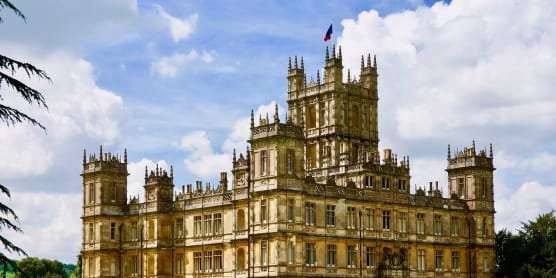
Highclere Castle is best known today as the filming location for the smash hit ITV show Downton Abbey, which aired from 2010 to 2015. It has also been a filming location for several movies including Robin Hood: Prince of Thieves, King Ralph and Eyes Wide Shut. Until March 2023, Highclere Castle hosted large weddings but ceased this service because of the staff limitations imposed due to Brexit.
Because of Highclere Castle's connection with Downton Abbey, it has become extremely popular with visitors from across the globe. And, it is included on many bus tours of Britain and Ireland. Some people might find the visit more cramped and fast-paced than they are used to, especially in the busier summer months. Early morning visits are the best way to avoid the huge crowds, but even this is not guaranteed.
Tours of Highclere Castle are self-guided, but there is staff at hand to answer any questions you may have. There is ample free parking on the grounds, close to the house. If you're travelling by train from London, take the London Paddington to Newbury connection. Outside Newbury station, you'll find taxis that can bring you the 10-minute drive to Highclere Castle. While there is access for people with mobility issues across the ground floor and garden, there are no lifts, so access to the bedrooms is restricted.
From early July to early September, Highclere Castle is open from Sunday to Thursday and is closed on Fridays and Saturdays.
Prices of a ticket to Highclere Castle range from £29 for an adult to £16 for a child.
Built by Thomas Coke during the 18th century, Holkham Hall remains in the Coke family to this day. Located in Norfolk, England, and built at the time for a massive £90,000, the completion of the house almost brought financial ruin to the Coke family. Thomas' descendants descendants could not alter the house in any meaningful way, and what we see today is an almost identical version of the property as it stood in 1764.
It is believed that Coke would have met the aristocratic architects Lord Burlington and William Kent while he undertook the Grand Tour between 1712 and 1718. The Grand Tour was a rite of passage through Europe taken by wealthy young Englishmen — often with Italy being the key destination. On arrival back to England, Coke made some unwise investments and took to drinking and gambling in excess. He died in 1759, but, five years later, his vision of Holkham Hall was completed, mainly under the guidance of Thomas' wife Lady Margaret Tufton.
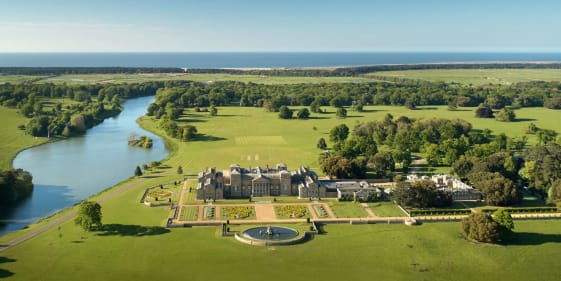
Today, Holkham Hall is a private estate that sprawls across almost 25,000 acres and is one of the finest examples of Palladianism architecture in the world. Reflecting the style choices of William Kent, who is said to have enjoyed "the eloquence of a plain surface", the interior is minimalist and decorations are kept to a minimum. Despite, or perhaps because of this, the rooms have a look of supreme luxury and grandeur. An odd quirk of the design is that all staterooms are kept symmetrical, with items such as false doors being added to parts of some rooms to keep them a mirror image of the other half of the room.
The interior of Holkham Hall may not be to everyone's taste. Palladian in style, and kept minimalist through designer William Kent's preferences, some people may find it dull and may prefer just strolling through the expansive grounds instead. For those who enjoy this style, it's well worth the visit.
You can take a tour of just the walled garden, or of the walled garden and the interior hall combined. Driving to Holkham Hall is advisable, where possible. There is a car park, that charges around £5 per car. The nearest train station is Kings Lynn, which is about an hour's drive away.
The Hall of Holkham Hall is open daily until October 31st, and the walled garden is open daily until November 3rd.
Prices of a ticket range from £24 for an adult to £1 for a child.
Castle Howard is an English country house built in the 18th century by Sir John Vanbrugh, one of England's most prominent architects, for the Howard family. It is located in the Howardian Hills, a designated Area of Outstanding Natural Beauty, about 15 miles north of York, England. It is a popular destination for visitors due to its picturesque setting amidst rolling countryside, lakes, and woodland. The house is still owned by the Howard's today, with Simon Howard, the 3rd Baron Howard of Penrith, currently residing there.
Vanbrugh began work on his design in 1699, and its final change occurred 112 years later, in 1811, with the decoration of the Long Gallery. The dome in the Central Block was finished between 1703 and 1706 and became the house's focal point. The Baroque architecture of Castle Howard is a true masterpiece, featuring an impressive facade, majestic domes, and intricate detailing. The house is renowned for its Great Hall, Long Gallery, and Marble Saloon. These rooms are adorned with stunning artworks and furnishings.
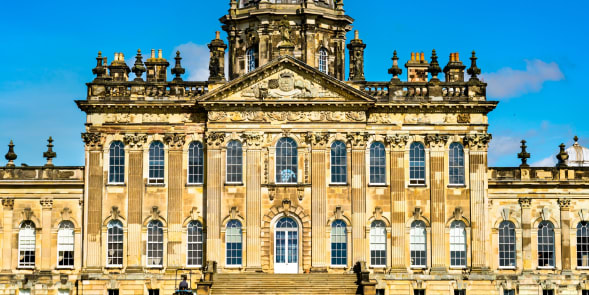
Castle Howard is a popular tourist destination that attracts visitors from around the world. It offers an opportunity to explore its historic interiors, art collections, and beautifully landscaped gardens. You can choose from guided tours, audio guides, and interactive exhibits to learn about the house's history, its architecture, and the lives of its inhabitants.
If you're bringing the little ones, there are several kids' play areas and a few cafés where you can stop as you stroll through the grounds.
Photography is usually permitted at Castle Howard. However, it is always recommended to ask a staff member if there are any restricted areas. The Castle provides accessibility services to ensure all visitors can have an enjoyable experience.
Castle Howard is open daily from 10am to 3pm.
Prices of a ticket to Castle Howard range from £28 for an adult to £9.50 for a child.